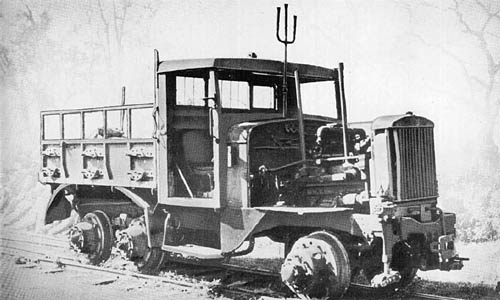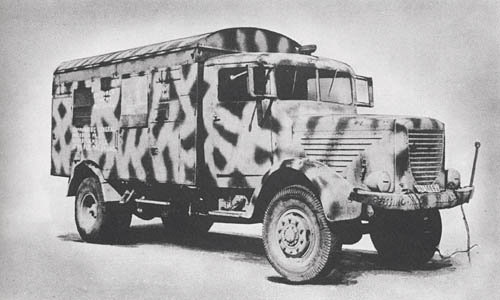
The German workshop train is reported to consist of eight vehicles, among which are (1) the spare parts truck which has a stake body and canvas top and carries various types of spare parts for automotive equipment stowed in cabinet bins; (2) the machine shop truck which has a van-type body and is equipped with electrically driven lathe, drill press, bench grinder, and valve grinding-machine, together with various tools used for automotive repair; (3) the electrical repair truck which has a van-type body and is equipped with armature grinder, battery chargers, soldering irons, spark plug tester, etc. The electrical repair truck is used in conjunction with automotive repair work as it is also equipped with wheel aligner and diesel injector testing machine.
The electrical motor-driven units of the two van-type trucks require an external source of current, believed to be either 220 volts or 380 volts inasmuch as the trucks have no generating equipment except for the starter and light circuits. By means of an electrical control panel, switches, and circuit breakers the correct voltage for use by the electric motors is selected from the external current, believed to emanate from a truck-drawn trailer fitted with generating equipment.
All three vehicles have the Bussing Nag 4½-ton truck chassis, Model 4500A four wheel drive.
The personnel of the entire train, including the foreman, drivers, electricians, tinsmiths, blacksmith, saddlemaker, painter, carpenter, and mechanics, numbers about thirty.
MACHINE SHOP TRUCK
SPECIFICATIONS
| Weight |
|
9.5 tons |
| Load |
|
9,620 lb. |
| Length |
|
24 ft., 11 ins. (overall) |
| Width |
|
7 ft., 6¾ ins. |
| Height |
|
10 ft., 1 in. (to top of body) |
| Ground clearance |
|
11 in. (front), 11¾ in (rear) |
| Wheelbase |
|
15 ft., 10 ins. |
| Length of body panel |
|
14 ft., 7¼ ins. |
| Front wheel centers |
|
6 ft., 4¾ ins. |
| Weight distribution |
| Front |
|
7,900 lb. |
| Rear |
|
11,060 lb. |
| Tires |
| Front |
|
270 x 20, single |
| Rear |
|
270 x 20, double |
| Fording depth |
|
30 ins. |
| Theoretical radius of action |
| Roads |
|
310 miles |
| Cross-country |
| Speed |
| Roads |
|
40 m.p.h. max.; 26 m.p.h. normal |
| Cross-country |
| Fuel tank capacity |
|
29 gals. |
| Engine |
|
Diesel, 4 cycle, 105 hp. at 1,800 r.p.m. |
| Transmission |
|
5 speeds forward, 1 reverse |
| Clutch |
|
Double plate, dry |
| Steering |
|
Normal, worm gear |
| Differential gear |
|
Spiral bevel type |
| Driving axle |
|
Floating type rear axle |
| Brakes |
|
Compressed air-hydraulic, 4 wheels |
| Crew |
German: p. 61
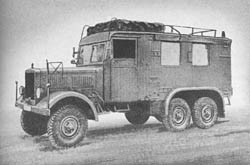 German nomenclature: Funkkraftwagen (Kurzwellan/Langwellan) (Kfz. 302) mit Einheitsfahrgestell für leichter Lastkraftwagen.
German nomenclature: Funkkraftwagen (Kurzwellan/Langwellan) (Kfz. 302) mit Einheitsfahrgestell für leichter Lastkraftwagen.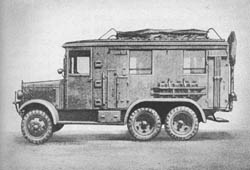 German nomenclature: Funkkraftwagen (Kfz. 61) mit Fehrgestell des leichter geländegängiger Lastkraftwagen (o).
German nomenclature: Funkkraftwagen (Kfz. 61) mit Fehrgestell des leichter geländegängiger Lastkraftwagen (o).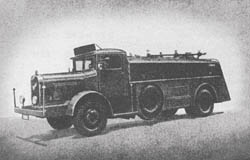 German nomenclature: schwerer Betriebstoffkesselkraftwagen (o) mit Fahrgestell des schwerer Lastkraftwagen (o).
German nomenclature: schwerer Betriebstoffkesselkraftwagen (o) mit Fahrgestell des schwerer Lastkraftwagen (o).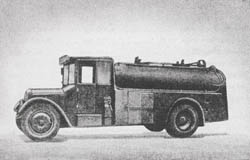 German nomenclature: mittlerer Betriebstoffkesselkraftwagen (o) mit Fahrgestell des mittleren Lastkraftwagen (o).
German nomenclature: mittlerer Betriebstoffkesselkraftwagen (o) mit Fahrgestell des mittleren Lastkraftwagen (o).
